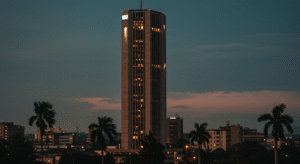Exploring the Erinford Principle in Kenya through the Skycrapers Africaway Case.
The “Skyscraper” Dream

When the directors of Skycrapers Africaway Company Limited (“the Developer”) broke ground on a new apartment project, their dream of a towering structure redefining the skyline felt within reach.
Backed by a Kshs. 43 million Musharaka facility from First Community Bank (“the Bank”), the partnership was, at least on paper, structured to share in both profits and losses. The model seemed simple: build, sell, repay, and grow.
However, unlike many stalled projects in Kenya’s real estate sector, this project collapsed, QUITE LITERALLY. Structural failure rendered the construction site commercially and physically untenable, and the building fell to rubble. The result? Sales dried up, buyers disappeared, and the Bank, keen to recover its investment, issued a statutory notice of sale to the Developer seeking to sell the property.
A Fight for Fairness: Skycrapers Africaway Company Limited & Anor -v- First Community Bank
Dissatisfied with the Bank’s decision to enforce repayment obligations following the project’s collapse, the Developer turned to the corridors of justice to forestall the impending sale of the property. The Developer’s position? The Bank had made misrepresentations of shared risk, and in the context of the failed project, the contractual representations on sharing losses could not be disregarded.
At the heart of the Developer’s claim was a plea for a permanent injunction to stop the statutory sale of the property as the Bank could not retreat from its shared risk obligations under the principles of Musharaka (joint venture). As part of its defense, the Bank invoked the doctrine of forum shopping, acquiescence of the loan obligations, and the need for good faith embedded in repaying the financing structure.
However, despite a spirited fight at trial, the trial Court dismissed the Developer’s case on 21st January 2020 authorising the sale of the property. In doing so, the trial Court found that the Developer could not escape liability or plead frustration simply because the project had failed. The obligation to repay stood firm, irrespective of whether the project succeeded or not.
Aggrieved by the trial Court’s failure to interrogate the distinctive character of the Musharaka arrangement and the false representations made by the Bank, the Developer lodged its appeal and sought to reignite this legal battle at the appellate Court.
The Comeback: Appeal, Auction, and a Race Against Time

In 2020, the Developer filed Civil Appeal No. 134 of 2020, seeking to stop the sale once more and challenge the trial Court’s judgment. However, justice at the appellate level moved ever so slowly.
The case backlog at the Court of Appeal delayed progress and just as the matter was slated for directions on a hearing date on 21st October 2024, the day was gazetted as a public holiday stalling the appellate process even further. The effect? Uncertainty on a new date for hearing of the appeal.
Keen to take advantage of this procedural delay, the Bank moved quickly. On 7th November 2024, the Bank placed the Developer’s property for public auction. Facing the imminent risk of losing the property, mind you the very subject of the appeal, the Developer turned back to the High Court, this time seeking a temporary injunction pending appeal.
The legal question emerged: Could a Court grant injunctive relief to a party after it had already dismissed its entire claim for a permanent injunction at trial?
The answer rested on the rarely invoked but powerful Erinford Principle.
The Erinford Principle Resurfaces and Takes Prominence in a Fair Trial Process
As the legal standoff escalated, the Developer approached the High Court once more to determine whether equity still had a role to protect the property pending the determination of the appeal through the Erinford Principle.
The Bank objected to the Developer’s application, arguing that the Court was functus officio, and it is only the Court of Appeal that could issue an injunction pending an appeal. It accused the Developer of forum shopping and abusing the Court process, but this time round, the High Court disagreed.
Quoting the English founding authority, Erinford Properties Limited -v- Cheshire County Council
[1974] ALL ER 448 in the Developer’s favour, the High Court held that its power to ensure equity and issue an injunction post-judgment derives from its inherent jurisdiction and not just procedural rules. In doing so, the Court observed: –
“When a party is appealing, exercising its undoubted right of appeal, the court ought to see that the appeal, if successful, is not nugatory….
It is preferable for the High Court to deal with such an application, in any event, not so much as to protect this court from a sudden inconvenient dislocation of its lists but more because this court would have the distinct advantage of seeing what the judge made of it. The learned judges of the High Court should take note of this concurrent jurisdiction which the two courts have and exercise theirs.”
Balancing the Scales & MMW Insights in Navigating Post-Judgment Rights
While the Judge was cautious that some borrowers often misuse injunctions as shields to evade their repayment obligations, the Court was convinced that the Developer had raised arguable issues, and the property, the very subject of litigation, risked irretrievable loss if sold before the appeal could be heard. The injunction was granted but the Developer was put on notice; equity cuts both ways.
This case reaffirms that Kenyan courts retain the power to preserve justice even after delivering final judgment, particularly where an appeal is pending and the risk of irreversible harm is real.
At the heart of the High Court’s ruling was the Erinford Principle, long overlooked, but in this instance, successfully invoked to protect the subject matter of a pending appeal.
MMW Advocates LLP is proud to have acted on behalf of the Developer, mounting a carefully structured application that ultimately secured the injunction pending final determination of the appeal at the Court of Appeal. In doing so, we helped preserve our client’s appeal, its property from an unjust statutory sale and re-opened the Developer’s claim at the appellate level, even after a final judgment had been rendered.
Written by: Ian Nyanchoga
